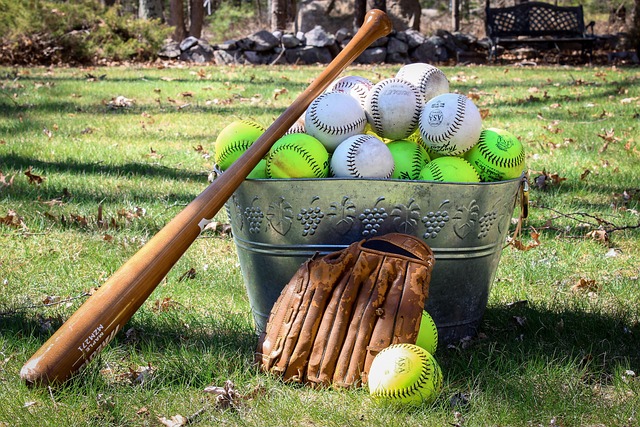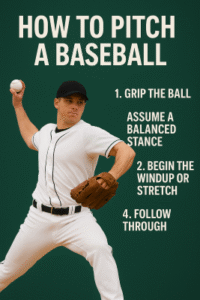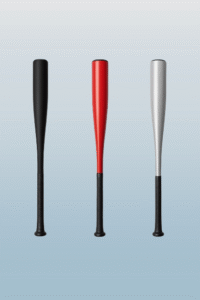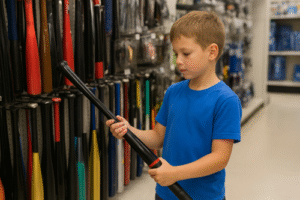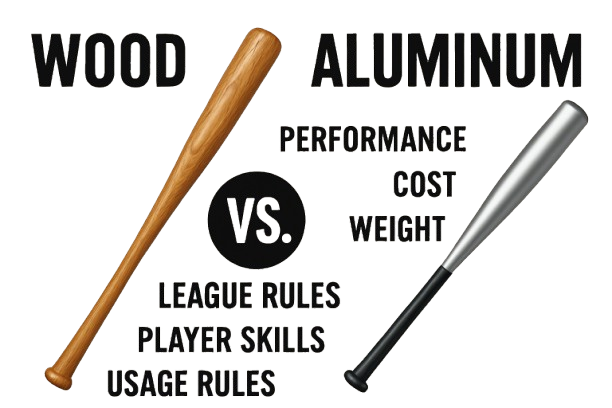
Baseball players often debate wood vs. aluminum (metal) bats. Each material has unique traits: wood bats (made of ash, maple, etc.) feel heavier and traditional, while aluminum bats are lighter and more forgiving. In adult amateur leagues, factors like league rules, player skill, and budget all play a role in choosing a bat. Below we examine wood vs. aluminum bat features, performance, and safety to determine which baseball bat might come out on top for 2025.
Overview of Wood vs Aluminum Bats
| Feature | Wooden Bat | Aluminum Bat |
| Material | Ash, maple, birch | Aluminum alloy, composite |
| Weight | Heavier | Lighter |
| Durability | Breaks with mishits | Highly durable |
| Performance | Requires precision hitting | Larger sweet spot, more forgiveness |
| Cost | Lower initial cost, needs replacing | Higher upfront cost, lasts longer |
| League Rules | Used in pro & some adult leagues | Common in amateur and recreational play |
| Feel & Sound | Classic crack of the bat | Metallic “ping” |
Wood bats are solid (commonly ash or maple) and prized for their “authentic” feel, while aluminum bats are hollow alloy cylinders. Wood’s heft can generate power, but it tends to be heavier overall. Aluminum bats are usually lighter and better balanced, allowing faster swing speeds.
In practice, wooden bats require precise contact: they have a smaller sweet spot, meaning good hits demand accuracy. Aluminum bats typically have a larger sweet spot, making solid contact easier. Wood bats are mostly used in professional and high-level play, whereas metal bats dominate youth, amateur, and college baseball due to their durability and performance benefits
Pros & Cons: Wood vs. Aluminum Bat
Wood Bats – Pros
Provide a natural feel and feedback on contact, helping hitters learn the sweet spot. Many players say a well-hit wood bat delivers exceptional distance. They also produce a classic “crack” sound and are required in pro leagues.
Wood Bats – Cons
More prone to breaking or cracking (especially maple). They are heavier and less forgiving, with a smaller sweet spot, so mishits can result in poor contact or splintering. Premium wood bats can be expensive, and hitters must replace them frequently as they wear out.
Aluminum Bats – Pros
Generally lighter and more durable under hard use. Their larger sweet spot yields more consistent results on off-center hits, boosting batting averages. Studies show aluminum bats yield higher batted‐ball speeds and longer hits on average. They don’t break like wood, so one bat can last many seasons.
Aluminum Bats – Cons
The increased trampoline effect can make the ball fly extremely fast, raising safety concerns. Many hitters report more stinging vibration on mishits. Metal bats also lack the tactile feedback of wood, which can mask swing flaws. Importantly, they are not allowed in pro leagues.
Metal vs. Wooden Bat: Performance Comparison
“Metal Bat vs Wooden Bat: Performance Comparison” with the factors you listed, in a simple table:
| Factor | Metal Bat | Wooden Bat |
|---|---|---|
| Bat Speed & Power | Generally lighter, allowing faster swings and more “trampoline effect” for added distance. | Heavier, requiring more strength; power comes purely from player’s swing. |
| Sweet Spot Size | Larger sweet spot; more forgiving on off-center hits. | Smaller sweet spot; mishits sting the hands and reduce performance. |
| Impact on Gameplay | Boosts offensive stats due to higher exit velocity; can make hitters more confident. | Demands precision; rewards good mechanics, exposes weaknesses. |
| Lifespan | Can last multiple seasons if cared for; less prone to breaking. | Can break with a single mishit; short lifespan is common. |
| Cost | Higher upfront cost but lasts longer, making it cost-effective over time. | Cheaper individually, but replacements can add up quickly. |
| Suitability for Different Levels of Play | Popular in youth, high school, and some college leagues; banned in pro leagues. | Required in MLB and many professional leagues; used by serious players for skill development. |
Safety Considerations and League Regulations
Safety First
Metal bats can send the ball flying faster, which means players have less time to react — so safety matters! Wooden bats don’t fly as fast but can sometimes break and splinter. Always check your bat for cracks or damage before you play.
What MLB Says
Only solid wood bats are allowed in MLB play. Bats must be made of a single piece of solid wood—neither hollow nor laminated. barrel that is no longer than 42 inches and no wider than 2.61 inches.
College Rules (NCAA)
Colleges allow metal bats, but they have to meet a special safety standard called BBCOR. This keeps metal bats from being too “bouncy.” The barrel can be up to 2 5/8 inches wide, and the bat’s weight follows strict limits.
High School Guidelines
High schools use the same BBCOR standard as colleges. Bats must be certified, have a max barrel of 2 5/8 inches, and meet weight rules to keep the game safe and fair.
Youth Baseball Basics
For kids and teens, leagues require bats that meet their safety standards—usually certified by USA or USSSA . Barrel sizes and bat performance depend on the player’s age. Always check what your league allows before buying a bat.
Personal Experience
In my own adult-league experience, I’ve swung both types. I noticed an aluminum bat feels noticeably lighter, so I could get the barrel through the zone quicker and often turned on fastballs for hard hits. However, mishits on aluminum sometimes rattled my hands, and I relied on the bat’s forgiveness.
A wood bat, by comparison, felt more stable and gave better feedback: I learned to focus on the bat’s smaller sweet spot. When I did hit a wood bat squarely, the ball really launched on a true line drive. Over a season, my slugging with aluminum was slightly higher, but I felt I improved my swing more when using wood.
Ultimately it matched expectations: metal helped pad stats in casual play, while wood demanded better fundamentals (and was more fun in a “classic baseball” sense).
Wood vs. Aluminum Bat: Pricing
Cost is often a deciding factor. Entry-level aluminum bats can be quite affordable, but high-end alloy/composite bats often cost 3–4× more than a quality wood bat. For example, a top college-metal BBCOR bat can run $300–$400, while a good wooden bat might be $50–$100.
BaseballMonkey notes that craftsmanship makes wood bats pricey, whereas aluminum bats (especially budget models) can cost less upfront. In practice, metal bats have a higher initial outlay but last for years, whereas wood bats are cheaper per bat but might need replacing multiple times.
Teams often weigh the long-term value: a $300 metal bat might be cheaper over multiple seasons than breaking a few $100 wood bats each year.
Wood vs. Aluminum Bat: Who is the Winner?
There is no absolute “winner” – the best bat depends on your needs. Your best bat is the one that feels right in your hands and helps you play your best game. Aluminum bats clearly excel in performance: studies show they drive up exit velocity and power, and their larger sweet spots help casual hitters.
For adult amateur leagues prioritizing offense and ease of use, metal bats often come out on top. Wood bats, however, excel in authenticity and player development. When hit in the sweet spot, a wood bat delivers unmatched distance and a satisfying line drive.
They teach proper hitting mechanics and are safer for pitchers/infielders due to lower exit speeds. Professional and wood-bat leagues emphasize these qualities. In the end, aluminum bats “win” for power and convenience in most adult league contexts, but wood bats “win” for tradition, feel, and the purest hitting experience.
If you want maximum offense and durability, aluminum is best; if you value skill development and pro-level play, wood is the way to go. Whatever you choose, always check your league’s bat rules and prioritize safety first.
Frequently Asked Questions
Are aluminum bats allowed in adult baseball leagues?
It depends on the league rules. Professional leagues (MLB) allow only wood bats. Most college and high school leagues allow alloy bats but require BBCOR certification to limit their power. Recreational adult leagues vary – some have wood-bat rules, others permit certified aluminum/USSSA bats – so always check your local league’s bat policy.
Which bat type tends to improve hitting performance?
Aluminum bats generally improve hitting performance thanks to their lighter weight, larger sweet spot, and trampoline effect, which can boost both swing speed and ball distance.
why does MLB use wooden bats ?
MLB uses wooden bats for several key reasons:
- Tradition – Wood bats have been part of professional baseball since the sport’s early days, preserving the game’s classic feel.
- Safety – Wood bats produce less exit velocity than aluminum, reducing injury risk to pitchers and infielders.
- Skill Development – The smaller sweet spot of wood forces players to refine their hitting mechanics.
- Fair Competition – Aluminum bats can give hitters an unnatural power boost, so wood keeps performance based on skill rather than technology.
What is the best wood bat?
The “best” wood bat depends on your hitting style, but in general:
All-Around Choice: Birch bats (e.g., Rawlings VELO Birch) – combines maple’s hardness with ash’s forgiveness.
Best for Power Hitters: Maple bats (e.g., Marucci AP5, Victus V-Cut) – hard, dense, and durable for maximum pop.
Best for Contact Hitters: Ash bats (e.g., Louisville Slugger MLB Prime Ash) – lighter with more flex for better bat control.
why does college baseball use aluminum bats ?
College baseball uses aluminum bats mainly because they are lighter, more durable, and offer better performance—which helps players generate faster swing speeds and more power. Aluminum bats also reduce equipment costs since they last longer than wood bats, making them ideal for college programs with tight budgets. Additionally, aluminum bats create a more exciting, offense-friendly game, which appeals to fans and players alike.

